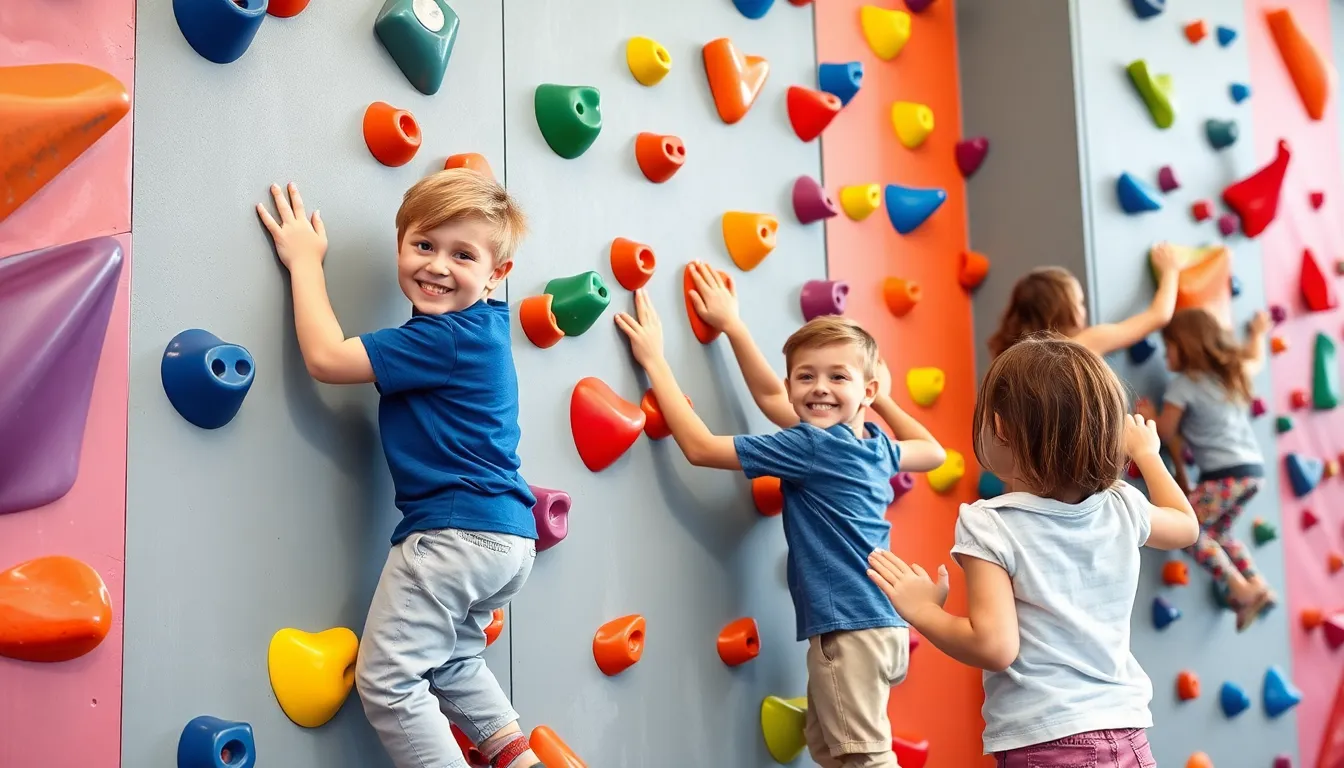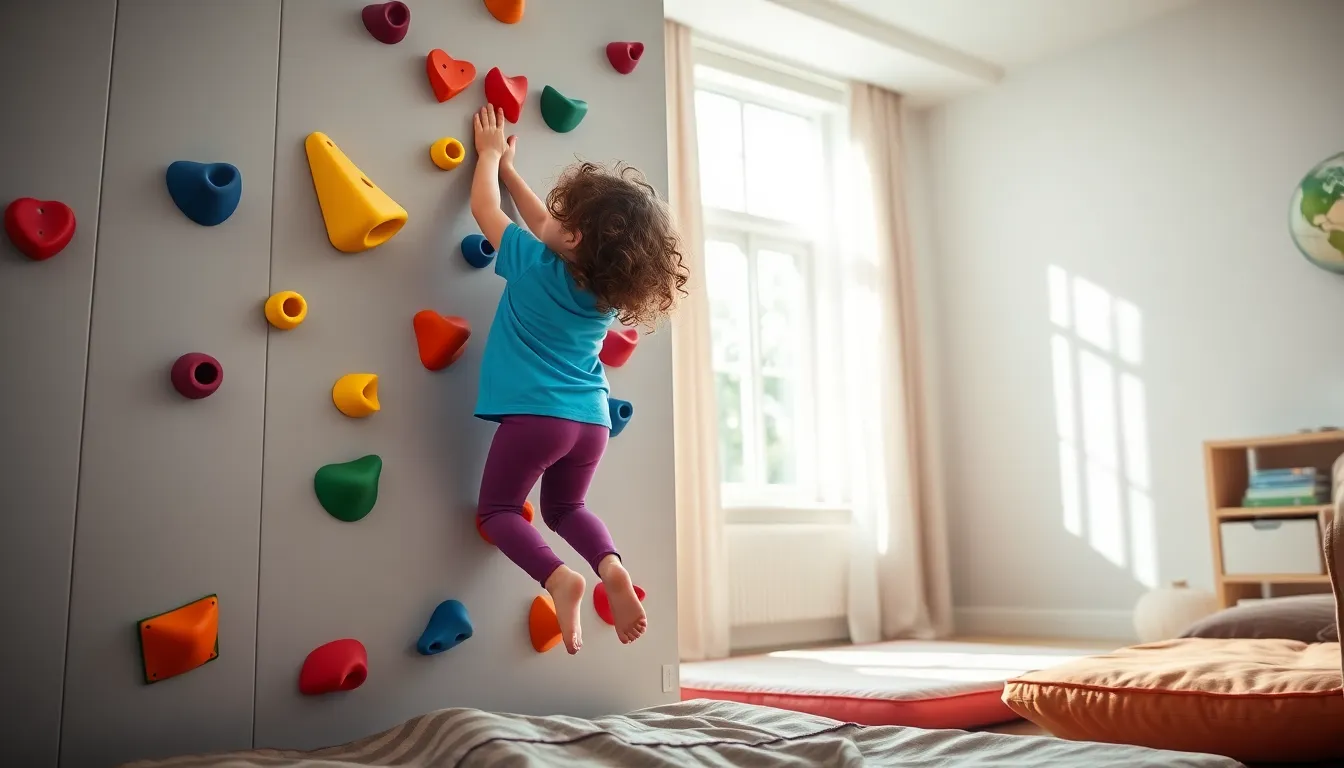Table of Contents
ToggleImagine transforming your living room into a mini rock-climbing gym without the need for a gym membership or a personal trainer. A DIY kids climbing wall not only fuels your child’s adventurous spirit but also keeps them active and engaged. It’s like giving them a ticket to the thrill of the great outdoors, all from the comfort of home.
What Is a DIY Kids Climbing Wall?
A DIY kids climbing wall is a custom-built climbing structure designed for indoor use. This wall offers a safe, controlled environment where children can practice climbing skills. Families create these walls using plywood sheets, climbing holds, and hardware. Builders often attach the wall to a sturdy frame or existing structure to ensure safety.
Children benefit from the physical activity provided by these climbing walls. Parents notice improvements in their child’s strength, coordination, and confidence as they climb. Additionally, it serves as an engaging way for kids to channel their energy constructively.
Creating a climbing wall allows customization based on available space and the child’s skill level. Builders can choose various angles, heights, and grip styles for the climbing surface. Many families opt to decorate the wall with bright colors or themes, making it visually appealing.
Safety remains a priority during construction. Using strong materials and secure fastenings guarantees stability under dynamic loads. Parents often place crash pads or soft mats beneath the wall to cushion falls and minimize injuries.
A DIY kids climbing wall not only provides an entertaining outlet for exercise but also fosters a spirit of adventure in children. This project has the potential to keep kids active and engaged, promoting healthy habits from a young age. Social interactions may also occur as kids invite friends for playdates and climbing sessions.
Benefits of a DIY Kids Climbing Wall

A DIY kids climbing wall provides numerous advantages for children. Engaging in this activity promotes healthy physical development, enhances cognitive skills, and fosters social interaction.
Physical Development
Building strength comes naturally through climbing. Muscles strengthen as children pull themselves up and maneuver around the wall. Coordination improves significantly with each climb; fine and gross motor skills receive a boost. Regular climbing sessions promote cardiovascular health, ensuring active children maintain fitness. Parents often notice enhancements in endurance and balance, contributing to overall physical growth. Additionally, tackling various heights and grips develops resilience. The thrill of conquering a climb builds confidence and encourages children to push their limits.
Cognitive Skills
Climbing challenges the brain as much as it does the body. Problem-solving skills emerge when children select routes and plan their movements. Quick decision-making becomes essential during climbs, enhancing critical thinking abilities. Spatial awareness improves while navigating the wall; children learn to judge distances and grasp dimensions. Concentration increases as they focus on each hold, fostering perseverance. Creativity flourishes when designing routes or attempting new climbing techniques. Building a DIY kids climbing wall encourages these cognitive developments, creating a stimulating indoor environment.
Social Interaction
Climbing promotes teamwork and communication among peers. Children often invite friends for climbing sessions, facilitating group play. Sharing the climbing experience encourages collaboration; they learn to cheer one another on while overcoming challenges. Interaction through this shared activity helps develop friendships and builds social skills. Applauding each other’s achievements fosters a sense of community. Organizing climbing games or challenges adds fun, further enhancing group bonding. As children engage in this collective experience, they cultivate camaraderie that translates into other areas of their lives.
Essential Materials and Tools
Building a DIY kids climbing wall requires specific materials and tools for safety and functionality. Each component plays a vital role in the overall success of the project.
Wood Types
Plywood offers a solid base for any climbing wall, ensuring durability and stability. Finding at least three-quarter-inch thick plywood provides a robust structure. Options like birch or marine-grade plywood resist wear and moisture, ideal for long-term use. Using more than one sheet allows for creative wall designs and various climbing angles. Choosing wood that is free of knots and imperfections further enhances the wall’s overall integrity.
Climbing Holds
Climbing holds come in various shapes and sizes, offering a customizable experience. Purchasing holds designed specifically for kids ensures safety and encourages confidence. Several colors and textures make the wall visually appealing and engaging for young climbers. Distributing holds evenly across the wall provides routes for different ability levels. Selecting holds made from durable materials, such as urethane or plastic, ensures longevity and enjoyment.
Safety Equipment
Safety equipment is essential for preventing injuries during climbing activities. Crash pads positioned at the base cushion falls, adding an extra layer of protection. Installing wall padding around the climbing surface minimizes impact in case of slips. Using harnesses for more advanced climbing scenarios promotes safety when navigating higher routes. Securing sturdy anchors for climbing holds prevents any unexpected accidents, enhancing the overall stability of the wall.
Step-by-Step Guide to Building a DIY Kids Climbing Wall
Creating a DIY kids climbing wall involves careful planning, construction, and safety considerations. Following these steps ensures an enjoyable and secure climbing experience.
Planning the Design
Design considerations vary based on available space and children’s ages. Start by measuring walls to determine dimensions and layout. Decide between a vertical or angled wall, depending on skill levels and climbing preferences. Sketch out the design, noting areas for climbing holds to promote diverse challenges. Parents often choose vibrant colors and themes, enhancing the wall’s appeal. A thoughtful plan helps ensure that each aspect contributes to an exciting climbing environment.
Construction Process
Gather materials before starting construction. Typically, three-quarter-inch thick plywood offers the required strength and stability. Cut the plywood into panels, following the designed dimensions. Securely attach panels to the wall frame using screws to ensure durability. Next, install climbing holds, varying shapes and textures to maintain interest. Many builders opt for multiple configurations to accommodate different climbing routes. Lastly, double-check all attachments and securely fasten each component for enhanced safety.
Safety Considerations
Safety plays a critical role in climbing wall construction. Always use high-quality, secure climbing holds designed for children’s use. Wall padding should cover any exposed areas to cushion falls, while crash pads provide additional protection at the base. Installing sturdy anchors ensures climbing holds remain secure during use. Regularly inspect the climbing wall, checking for wear and tear or loose components. Prioritizing safety measures prevents injuries and creates a secure environment for children to enjoy their adventures.
Maintenance and Safety Tips
Regular inspections play a vital role in maintaining a DIY kids climbing wall. Inspect climbing holds for signs of wear or looseness before each use. Tighten any loose screws or hardware to ensure the climbing holds remain securely attached.
Keep the climbing surface clean and free from debris. Wipe down the plywood and holds periodically to prevent dirt buildup. Cleaning helps maintain grip and ensures children climb safely.
Check padding and crash mats regularly for signs of damage. Replace any worn or torn padding to avoid injuries from falls. Adequate cushioning helps absorb impact and provides a safer climbing environment.
Reinforce safety rules before climbing sessions. Encourage children to use proper techniques, such as three points of contact. Remind them to avoid roughhousing and to take turns on the climbing wall to promote safety.
Limit climbing to one child at a time during initial use. This approach helps monitor activity and allows for personalized guidance. Once familiar with the wall, children can begin climbing in pairs or small groups.
Consider installing a harness or safety rope system for high walls. Using harnesses can significantly reduce fall risk when climbing at higher levels. Ensure children understand how to use safety gear properly.
Utilize bright colors or signs to mark climbing zones or safety areas around the wall. Visual indicators help remind children of boundaries and safety protocols. Promoting awareness enhances the overall safety experience.
Engage with children during climbing sessions to provide encouragement and support. Active participation strengthens concepts of teamwork and builds confidence. Monitoring their progress ensures a positive and safe climbing experience.
Creating a DIY kids climbing wall offers a unique opportunity for children to engage in physical activity while fostering their adventurous spirit. This project not only enhances their strength and coordination but also promotes cognitive skills and social interaction.
With careful planning and attention to safety, families can build a fun and stimulating environment right at home. The customization options allow for a personalized climbing experience that keeps kids excited and challenged.
By investing time and effort into this project, parents can provide their children with a valuable outlet for energy and creativity, contributing to their overall development and well-being. A DIY climbing wall is more than just a play structure; it’s a gateway to growth, exploration, and countless joyful moments.




